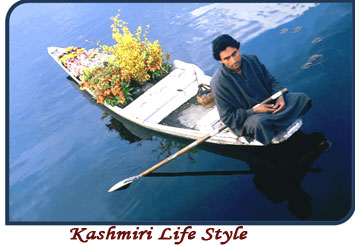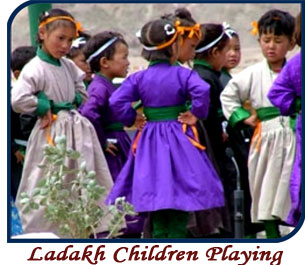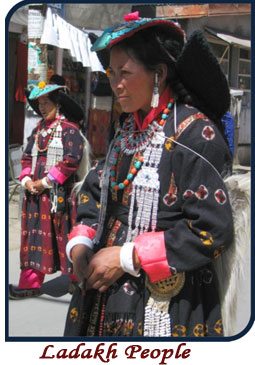Culture of Kashmir...
 Gaffara Tour & Travels offers you a glimpse into the culture and traditions of the state of Jammu and Kashmir. The state has a rich cultural heritage and has a wealth of ancient literature, language, religion, arts, crafts and music. Tours and travel to the state of Kashmir offers you an opportunity to feel the rich and deep-rooted ancient tradition in the Indian culture.
Gaffara Tour & Travels offers you a glimpse into the culture and traditions of the state of Jammu and Kashmir. The state has a rich cultural heritage and has a wealth of ancient literature, language, religion, arts, crafts and music. Tours and travel to the state of Kashmir offers you an opportunity to feel the rich and deep-rooted ancient tradition in the Indian culture.
Infact, the people of Kashmir have made significant contribution in the fields of story telling, poetry, philosophy, sciences, etc. The handicrafts of Kashmir like Pashmina shawls, papier-m�ch� products, silk carpets, woodwork, etc are admired throughout the world. Celebrations and festive activities during festivals offer an important diversion to the simple and monotonous lifestyle of these people. The festivals that are celebrated with great fervor include, Id-ul-fitr, Diwali, Hemis festival, Navratras and the Loshar festival. Tours and travel to the state of Kashmir gives you a chance to see a secular Indian tradition where the people of different religions celebrate their colorful festivals with gusto and enthusiasm. The houses in the area usually have a lot of woodwork; as a result the interiors are very warm. The brick houses have pagoda roofs and picturesque facades.  The Lifestyle of the local people is quite slow in the old city. The waterways and shikaras are the best way of going into the interiors of the old city. Women are very enterprising, they sell food items, flowers and handcrafted items on their floating markets. Kashmiris use willow baskets for carrying essential items from one place to the other. There are a number of open-air markets in the old city. Here visiting tourists have the pleasure of buying all the traditional Kashmiri spices and food items. Tours and travel to the state of Kashmir also tempts you to shop in the open air markets in the old city where one is likely to find all those traditional items that are used in the kitchens of these simple people. Culture of Ladakh...  Buddhism is the way of life in Ladakh. There are ancient Buddhist rock engravings all over the region, even in areas like Dras and the lower Suru Valley which today are inhabited by an exclusively Muslim population. The divide between Muslim, and Buddhist Ladakh passes through leh (on the Kargil-Leh road) and between the villages of Parkachick and Rangdum in the Suru Valley, though there are pockets of Muslim population further east, in Padum (Zanskar), in Nubra Valley and in and around Leh. The approach to Buddhist village is invariable marked by mani walls which are long chest-high structures faced with engraved stones bearing the mantra in mane paddle hum and by shorten, commemorative cairns, like stone pepper-pots.
Buddhism is the way of life in Ladakh. There are ancient Buddhist rock engravings all over the region, even in areas like Dras and the lower Suru Valley which today are inhabited by an exclusively Muslim population. The divide between Muslim, and Buddhist Ladakh passes through leh (on the Kargil-Leh road) and between the villages of Parkachick and Rangdum in the Suru Valley, though there are pockets of Muslim population further east, in Padum (Zanskar), in Nubra Valley and in and around Leh. The approach to Buddhist village is invariable marked by mani walls which are long chest-high structures faced with engraved stones bearing the mantra in mane paddle hum and by shorten, commemorative cairns, like stone pepper-pots. Many villagers are crowned with a gompa or monastery which may be anything from an imposing complex of temples, prayer halls and monks dwellings, to a tiny hermitage housing a single image and home to solitary lama. Islam too came from the west. A peaceful penetration of the Shia sect spearheaded by missionaries, its success was guaranteed by the early conversion of the sub-rulers of Dras, Kargil and the Suru Valley. In these areas, mani walls and shorten are placed by mosques, often small unpretentious buildings, or Imambaras imposing structures in the Islamic style, surmounted by domes of sheet metal that gleam cheerfully in the sun. Many villagers are crowned with a gompa or monastery which may be anything from an imposing complex of temples, prayer halls and monks dwellings, to a tiny hermitage housing a single image and home to solitary lama. Islam too came from the west. A peaceful penetration of the Shia sect spearheaded by missionaries, its success was guaranteed by the early conversion of the sub-rulers of Dras, Kargil and the Suru Valley. In these areas, mani walls and shorten are placed by mosques, often small unpretentious buildings, or Imambaras imposing structures in the Islamic style, surmounted by domes of sheet metal that gleam cheerfully in the sun.
In Leh area women of both the communities, Buddhist and Muslim, enjoy a greater freedom than other parts of the region. They not only work in the house and field, but also do business and interact freely with men other than their own relations. In Kargil and its adjoining regions on the other hand, it is only in the last few years that women are merging from semi-seclusion and taking jobs other than traditional ones like farming and house-keeping. Ceremonial and public events are accompanied by the characteristic music of 'Surna' and 'Daman' (Oboe and drum), originally introduced into Ladakh from Muslim Baltistan, but now played only by Buddhist musicians known as "Mons". |